Advertisements
Online Mock Tests
Chapters
![Samacheer Kalvi solutions for Science - Term 3 [English] Class 7 TN Board chapter 1 - Light Samacheer Kalvi solutions for Science - Term 3 [English] Class 7 TN Board chapter 1 - Light - Shaalaa.com](/images/science-term-3-english-class-7-tn-board_6:5f2b1b2038084cf381bfa42c826a928c.jpg)
Advertisements
Solutions for Chapter 1: Light
Below listed, you can find solutions for Chapter 1 of Tamil Nadu Board of Secondary Education Samacheer Kalvi for Science - Term 3 [English] Class 7 TN Board.
Samacheer Kalvi solutions for Science - Term 3 [English] Class 7 TN Board 1 Light Evaluation [Pages 19 - 22]
The image formed by a pinhole camera is inverted because,
light travels in straight lines
light rays become laterally inverted as they pass through a pinhole camera
light rays pass through the pinhole
light rays get reflected
Choose the correct option
Light travels only in a______ It is because of this property that______ are formed.
curved line, shadows
straight line, shadows
straight line, reflection
curved line and then straight line, shadows
Which of the following facts explain how shadows are formed?
- Light travels in straight lines
- Opaque bodies do not allow light to pass through them
- Reflection occurs at a smooth surfaces like mirrors
- Lateral inversion happens
both A and B
both A and D
both B and C
only A
Light that hits a mirror gets ______.
Transmitted
Reflected
Absorbed
Refracted
______Surface reflects the light well.
water
compact disc
mirror
stone
Light is a form of ______.
matter
energy
medium
particle
You can see your image in polished floors, but not in wooden table because ______.
regular reflection takes place in wooden table and irregular reflection in polished floor
regular reflection takes place in polished floor and irregular reflection in wooden table
regular reflection takes place in both polished floor and wooden table
irregular reflection takes place in both polished floor and wooden table
Choose the translucent substance from the following
glass
wood
water
Clouds
Reflection occurs , when the light
about to reach a surface
approaches a surface
passes through a surface
None of these
Which of the following is the best reflector of light?
plastic plate
plane mirror
wall
paper
Sivarajan placed a meter stick in the playground at 7.00 am in the morning. How will the shadow of the stick at noon look in comparison to the one in the morning
There will be no shadow
The shadow will be longer and on the opposite side as the sun
The shadow will be shorter and on the same side as the sun
The shadow will be shorter
Fill in the blanks.
A plane mirror produces a ______image.
A ______ reflection helps us to see the object
The light ray gets _______ when it falls on any polished surface.
Sunlight is a blend of______ colors
The splitting of white light in to seven colors is called ______.
The moon ______ sun light.
The sunlight can be split into its constituent colors using ______.
Reflection of light from rough surface is called ______ reflection
Say TRUE or FALSE
A shadow is formed on the same side of the object as the source of light.
True
False
Say TRUE or FALSE
The image of right hand in a plane mirror looks like a left hand
True
False
Say TRUE or FALSE
we are able to see things around us with the help of regular reflection
True
False
Say TRUE or FALSE
After passing through a prism, white light splits into a band of seven colours
True
False
Say TRUE or FALSE
Rainbow is formed by dispersion of which light by water drops
True
False
Say TRUE or FALSE
The image formed by the plane mirror is laterally inverted, hence the image seen through the periscope is also laterally inverted
True
False
Say TRUE or FALSE
We see planets because they reflect light from the sun
True
False
Say TRUE or FALSE
We see a book because it reflects the light that falls on its surface
True
False
Say TRUE or FALSE
The image formed in a pinhole camera is always inverted
True
False
Say TRUE or FALSE
The image formed in a pinhole camera is always the same size as the object
True
False
Say TRUE or FALSE
The image formed in a plane mirror is upside down
True
False
Say TRUE or FALSE
A plane mirror is opaque
True
False
Match the following
| 1. | Rectilinear propagation | Primary source of light |
| 2. | Plane Mirror | Non-luminous object |
| 3. | Fire fly | Periscope |
| 4. | The Moon | Pinhole camera |
| 5. | Wide light source | Spectrum of light |
| 6. | Regular reflection | luminous object |
| 7. | The sun | Penumbra |
| 8. | Band of seven colors | Glossy surface |
Answer the following questions in short
With the help of a diagram, state the laws of reflection
Figure shows a pencil placed above a mirror
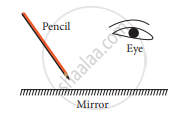
- Draw its image formed by the mirror
- Show how light rays from the object are reflected at the mirror to form the image for the eye.
A person is looking at the image of a tree in a mirror placed 3.5 m in front of him. Given that the tree is at 0.5 m behind his eyes. Find the distance between the image of the tree and his eyes. What are needed to see an object?
What are luminous objects?
Is the moon a luminous object?
What are the three types of materials based on the absorption of light?
What are the parts of shadow?
What are the properties of shadow?
What is plane mirror?
What is prism?
What do you mean by visible light?
Write the items given here in the correct column
(Stars, brick walls, plants, mirror, planets, electric light bulb,candle)
| Sources of Light | Objects that reflect light |
A boy of height 1m 45 cm is standing in front of a long mirror at a distance of 2 m. From this information, fill up the following sentences:
- The distance between the boy and his image is ______
- The height of the image is______
- When the boy moves 1m forward, the distance between her and her image is______
Draw a diagram of a pin hole camera showing the rays of light passing between the Object and its image
Why is the writing on the front of an ambulance back to front as shown in the picture?
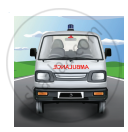
Explain with examples, why some capital letters look the same in a mirror but others are reversed.
Two plane mirrors M1 and M2 are placed perpendicular with each other, as shown in figure. The ray AB makes an angle 39 ° with the plane mirror M1, then
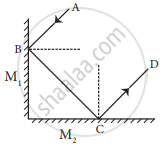
- The reflected rays are ______ ______
- The incident rays are ______ ______
- What is the angle of incident corresponding to the ray BC?
- What is the angle of reflection corresponding to the ray CD
Rajan was playing with the mirror images of a clock. He looked at the clock in his room. It was showing 1:40. Draw the position of the hands on the real clock and on its mirror reflection. Write below the picture what time each picture is showing.
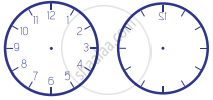
What is reflection of light?
If a ray of light is falling on a plane mirror at an angle of 500 is formed, what will be the angle of reflection?
What do you mean by lateral inversion?
How do you obtain a spectrum of light?
Why do we see white color in Newton’s disc, when we rotate it very fast?
What is a shadow? What things are necessary for the formation of a shadow?
Answer the following questions in detail
What are regular and irregular reflection? Explain with the help of diagrams
What are the difference between luminous and non-luminous objects? Give two examples of each.
Write about two everyday situations that tell you that light travels in a straight line.
Differentiate between a reflection and a shadow
What are the characteristics of an image formed in a plane mirror?
Describe the pictures.
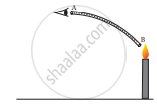
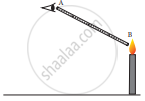
Define the following term
Incident ray
Define the following term
Reflected ray
Define the following term
Normal
Define the following term
Angle of incidence
Compare the images formed by plane mirror with that by pinhole camera
Solutions for 1: Light
![Samacheer Kalvi solutions for Science - Term 3 [English] Class 7 TN Board chapter 1 - Light Samacheer Kalvi solutions for Science - Term 3 [English] Class 7 TN Board chapter 1 - Light - Shaalaa.com](/images/science-term-3-english-class-7-tn-board_6:5f2b1b2038084cf381bfa42c826a928c.jpg)
Samacheer Kalvi solutions for Science - Term 3 [English] Class 7 TN Board chapter 1 - Light
Shaalaa.com has the Tamil Nadu Board of Secondary Education Mathematics Science - Term 3 [English] Class 7 TN Board Tamil Nadu Board of Secondary Education solutions in a manner that help students grasp basic concepts better and faster. The detailed, step-by-step solutions will help you understand the concepts better and clarify any confusion. Samacheer Kalvi solutions for Mathematics Science - Term 3 [English] Class 7 TN Board Tamil Nadu Board of Secondary Education 1 (Light) include all questions with answers and detailed explanations. This will clear students' doubts about questions and improve their application skills while preparing for board exams.
Further, we at Shaalaa.com provide such solutions so students can prepare for written exams. Samacheer Kalvi textbook solutions can be a core help for self-study and provide excellent self-help guidance for students.
Concepts covered in Science - Term 3 [English] Class 7 TN Board chapter 1 Light are Light, Sources of Light, A Pinhole Camera, Reflection of Light, Terms Used in Reflection of Light, Law of Reflection of Light, Types of Reflection, Luminous and Non-luminous Bodies, The propagation of light, Important Terms Related to Light, Formation of Shadow, Lateral Inversion, Formation of Image by Reflection: Real and Virtual Image, Eclipse - an Astronomical Event, Prism, Colour, Dispersion of Light Through Prism and Formation of Spectrum, Speed of Light, Formation of Shadow.
Using Samacheer Kalvi Science - Term 3 [English] Class 7 TN Board solutions Light exercise by students is an easy way to prepare for the exams, as they involve solutions arranged chapter-wise and also page-wise. The questions involved in Samacheer Kalvi Solutions are essential questions that can be asked in the final exam. Maximum Tamil Nadu Board of Secondary Education Science - Term 3 [English] Class 7 TN Board students prefer Samacheer Kalvi Textbook Solutions to score more in exams.
Get the free view of Chapter 1, Light Science - Term 3 [English] Class 7 TN Board additional questions for Mathematics Science - Term 3 [English] Class 7 TN Board Tamil Nadu Board of Secondary Education, and you can use Shaalaa.com to keep it handy for your exam preparation.
